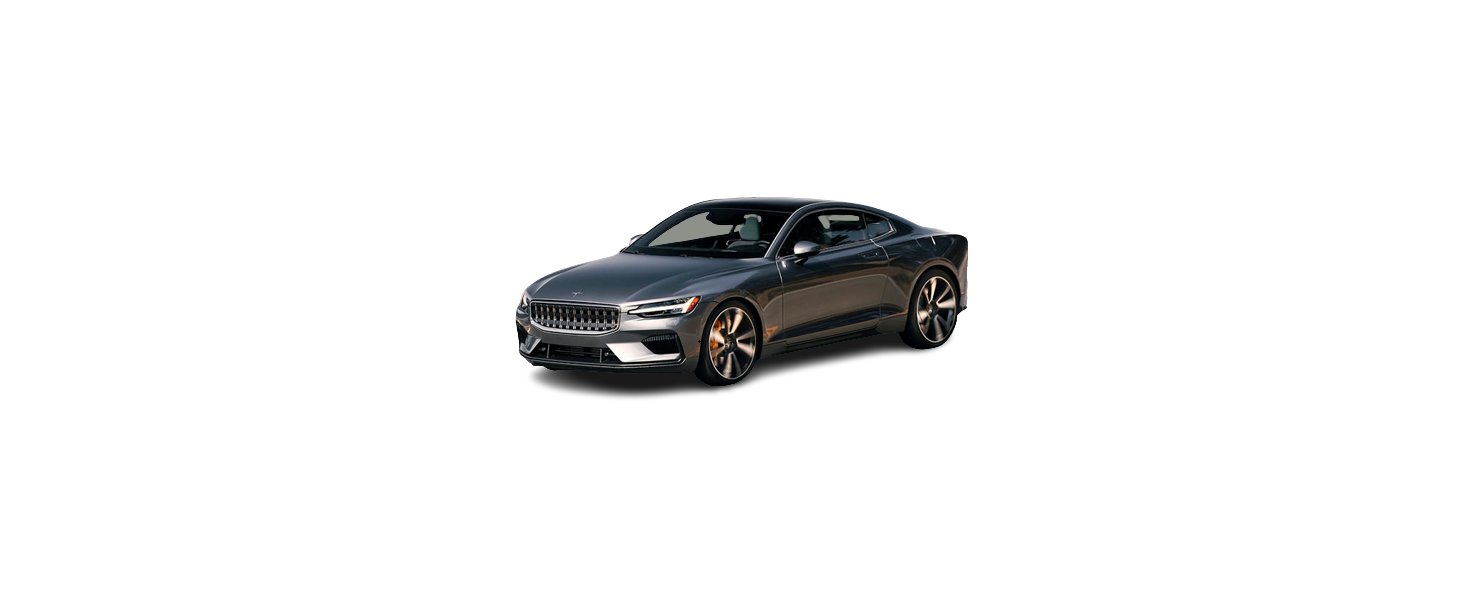2021 Polestar 1 City Safety
Automatic braking during delayed evasive maneuvers with City Safety
City Safety can assist the driver by automatically braking the vehicle when it is not possible to avoid a collision by steering alone.
City Safety assists the driver by periodically attempting to predict possible “escape routes” to the sides of the vehicle in the event a slow-moving or stationary vehicle was to be detected at a late stage.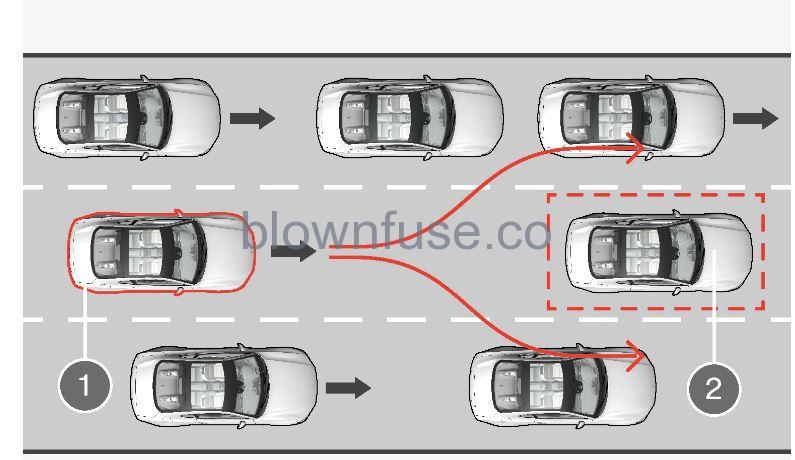
Your vehicle (1) cannot detect any potential escape routes for veering away from the vehicle ahead (2) and may therefore apply the brakes at an earlier stage.
- Own vehicle
- Slow-moving/stationary vehicles
City Safety will not intervene to automatically apply the brakes if it is possible for the driver to avoid a collision by steering the vehicle.
However, if City Safety determines that an evasive maneuver would not be possible due to traffic in the adjacent lane(s), the function can assist the driver by automatically starting to apply the brakes at an earlier stage.
City Safety braking for oncoming vehicles
City Safety can help you apply the brakes for an oncoming vehicle in your lane.
If an oncoming vehicle veers into your lane and a collision is unavoidable, City Safety can help reduce your vehicle’s speed to attempt to mitigate the force of the collision.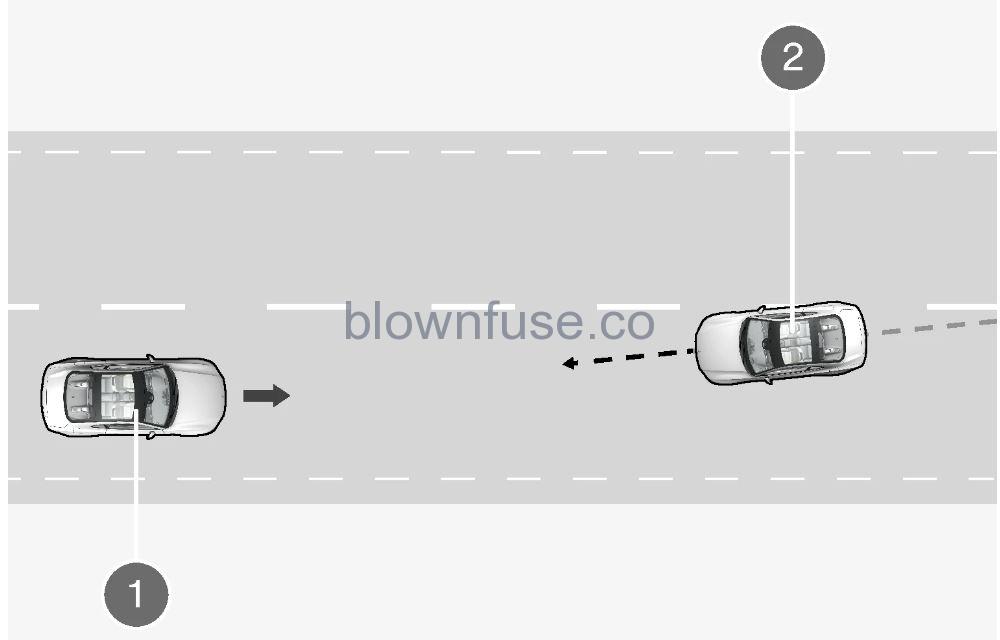
- Own vehicle
- Oncoming vehicles
The following criteria must be met for the function to work:
- your vehicle’s speed must be above 4 km/h (3 mph)
- the road must be straight
- your lane must have clear side lane markings
- your vehicle must be positioned straight in your lane
- the oncoming vehicle must be positioned within your vehicle’s lane markings
- the oncoming vehicle’s headlights must be on
- the function can only handle “front-to-front” collisions
- the function can only detect vehicles with four wheels.
WARNING
City Safety in crossing traffic
City Safety can assist the driver when turning into the path of an oncoming vehicle in an intersection.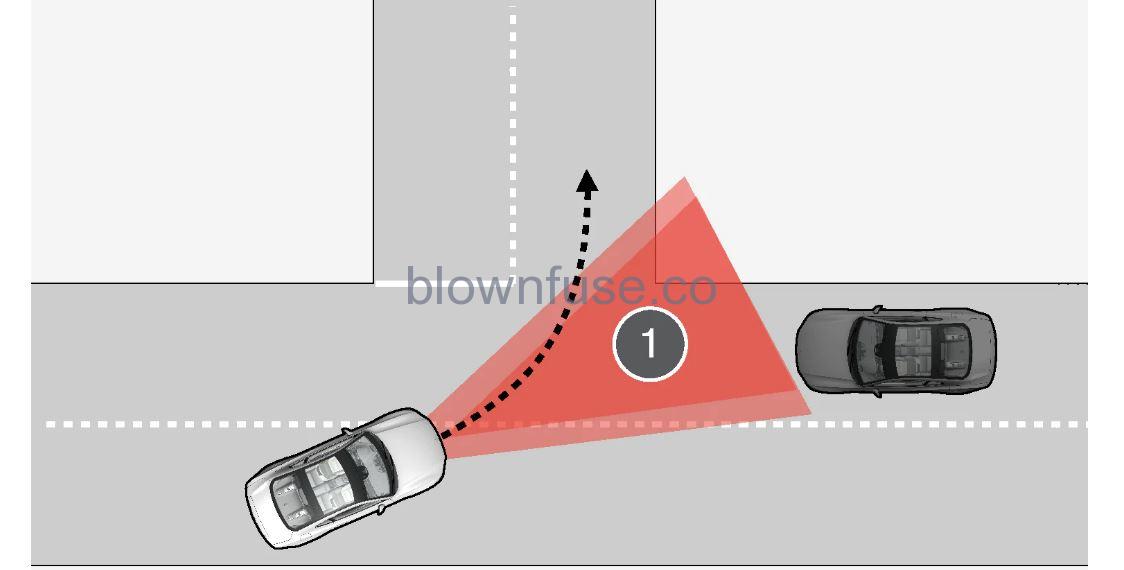
- Sector in which City Safety can detect an oncoming vehicle in crossing traffic.
In order for City Safety to detect an oncoming vehicle in situations where there is a risk of a collision, that vehicle must be within the sector in which City Safety can analyze the situation.
The following criteria must also be met:
- your vehicle’s speed must be at least 4 km/h (3 mph)
- your vehicle must be making a left turn
- the oncoming vehicle’s headlights must be on
City Safety limitations
City Safety functionality may be reduced in certain situations.
Surroundings
Low objects
Hanging objects, such as flags for overhanging loads or accessories such as auxiliary lights or front protective grids that extend beyond the height of the hood, may limit City Safety functionality.
Slippery road conditions
The extended braking distance on slippery roads may reduce City Safety‘s capacity to help avoid a collision. In these types of situations, the Anti-lock Braking System and Electronic Stability Control (ESC) are designed for optimal braking power with maintained stability.
Backlighting
The visual warning signal in the windshield may be difficult to detect in bright sunlight, if there are reflections, or if the driver is wearing sunglasses or not looking straight ahead.
Heat
If the temperature in the passenger compartment is high due to e.g. bright sunlight, the visual warning signal in the windshield may be temporarily disabled.
Camera and radar sensor’s field of vision
The camera’s field of vision is limited and in certain situations, it may be unable to detect pedestrians, large animals, cyclists, or vehicles, or it may detect them later than expected.
Vehicles that are dirty may be detected later than clean vehicles, and in dark conditions, motorcycles may be detected late or not at all.
If a text message displayed in the instrument panel indicates that the camera or radar sensor is obstructed, it may be difficult for City Safety to detect pedestrians, large animals, cyclists, vehicles, or lane markings in front of the vehicle. City Safety functionality may therefore be reduced.
Text messages may not be displayed for all situations in which the windshield sensors are blocked. The driver must therefore always keep the windshield in front of the camera/radar sensor clean.
NOTE
Driver intervention
Backing upCity Safety is temporarily deactivated when the vehicle is backing up.
Low speedCity Safety is not activated at very low speeds under 4 km/h (3 mph). The system will therefore not intervene in situations in which your vehicle is approaching another vehicle very slowly, such as when parking.
Active driverAction by the driver always has priority. City Safety will therefore not react or will react at a later stage with a warning or intervention in situations in which the driver is clearly steering and operating the accelerator pedal, even if a collision is unavoidable.
An active and aware driving style may therefore delay collision warnings and intervention in order to minimize unnecessary warnings.
Market limitations
City Safety is not available in all countries. If City Safety is not shown in the center display’s Settings menu, your vehicle is not equipped with this function.
In the center display’s Top view, tap:
The driver support system only issues a warning for obstacles detected by its camera and radar units, which means that warnings may come after a delay or not at all.
- Never wait for a warning or assistance. Apply the brakes when necessary.
- Warnings and brake interventions can be triggered late or not at all if the traffic situation or external influences prevent the camera and radar unit from properly detecting pedestrians, cyclists, large animals or vehicles ahead of the vehicle.
- To be able to detect vehicles at night, their front and rear lights must work and illuminate clearly.
- Warnings for stationary or slow-moving vehicles and large animals may be disabled due to darkness or poor visibility.
- Warnings and brake interventions for pedestrians and cyclists are disengaged at vehicle speeds over 80 km/h (50 mph).
- The system can provide effective warnings and brake intervention if the relative speed is lower than 50 km/h (30 mph).
- For stationary or slow-moving vehicles, warnings and brake interventions are effective at vehicle speeds of up to 70 km/h (43 mph).
- The speed reduction for large animals is less than 15 km/h (9 mph) and can be achieved at vehicle speeds over 70 km/h (43 mph). At lower speeds, the warning and brake intervention for large animals is less effective.
- Do not place, affix or mount anything on the inside or outside of the windshield, or in front of or around the camera and radar unit – this could disrupt camera-based functions.
- Objects, snow, ice, or dirt in the area of the camera sensor can reduce the function, disengage it completely or give an improper function response.
- Auto-braking can prevent a collision or reduce collision speed, but to ensure full brake performance the driver should always depress the brake pedal – even when the vehicle brakes automatically.
- The warning and steering assistance are only activated if there is a high risk of collision – you must therefore never wait for the collision warning or the function to intervene.
- The function does not activate automatic braking intervention during heavy acceleration.
Only a workshop may perform maintenance on driver support components – contact Polestar Customer Support.
City Safety messages
A number of messages related to City Safety may be displayed in the instrument panel. Several examples are provided below.
| Message | Meaning |
|---|---|
| City Safety
Automatic intervention |
When City Safety is braking or has activated the automatic braking function, one or more symbols may illuminate in the instrument panel and a text message may be displayed. |
| City Safety
Reduced functionality Service required |
The system is not functioning as intended. Contact Polestar Customer Support. |
A text message can be erased by briefly pressing the button in the center of the right-side steering wheel keypad.
If a message cannot be erased, contact Polestar Customer Support.
City Safety steering assistance for an evasive maneuver
City Safety steering assistance can help the driver steer away from a vehicle/obstacle when it is not possible to avoid a collision by braking alone. City Safety steering assistance is always activated and cannot be switched off.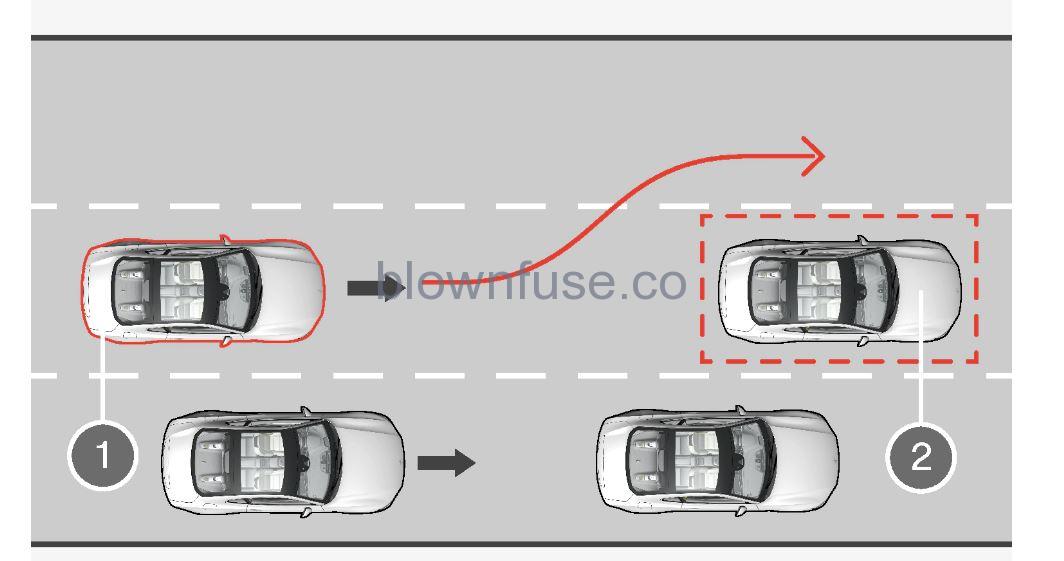
- Your vehicle swerves away
-
Slow-moving/stationary vehicle or obstacle.
City Safety helps provide assistance by strengthening the driver’s steering movements, but only if the driver has begun evasive action and the system detects that the driver’s steering movements are not sufficient to avoid a collision.
The brake system is used simultaneously to further strengthen steering movements. The function also helps stabilize the vehicle after it has passed the obstacle.
City Safety steering assistance can detect:
- vehicles
- cyclists
- pedestrians
- large animals
City Safety steering assistance limitations during evasive maneuvers
City Safety steering assistance may have limited functionality in certain situations and not intervene, e.g.:
- at speeds outside the range of 50-100 km/h (30-62 mph)
- if the driver does not take evasive action
- if speed-dependent power steering wheel resistance is working at reduced power – e.g. during cooling due to overheating.
NOTE
The function uses the vehicle’s camera and/or radar units, which have certain general limitations.
City Safety sub-functions
City Safety can help prevent a collision or lower the vehicle’s speed at the point of impact. The function consists of several subfunctions.
Ability to reduce speed the speed difference between your vehicle and the obstacle is greater than the speeds given below, the City Safety auto-brake function cannot prevent a collision but can reduce its consequences.
VehiclesCity Safety can help prevent a collision with a vehicle ahead by reducing your vehicle’s speed by up to 60 km/h (37 mph).
CyclistsCity Safety can help prevent a collision with a cyclist ahead by reducing your vehicle’s speed by up to 50 km/h (30 mph).
PedestriansCity Safety can help prevent a collision with a pedestrian ahead by reducing your vehicle’s speed by up to 45 km/h (28 mph).
Large animals there is a risk of colliding with a large animal, City Safety can help reduce your vehicle’s speed by up to 15 km/h (9 mph).
The braking function for large animals is primarily intended to mitigate the force of a collision at higher speeds. Braking is most effective at speeds above 70 km/h (43 mph) and less effective at lower speeds.
City Safety steps
City Safety carries out three steps in the following order:
- Collision warning
- Brake assistance
- Auto-brake
Collision warning
The driver is first alerted to the risk of an imminent collision.
A flashing warning symbol is shown on the windshield in the head-up display.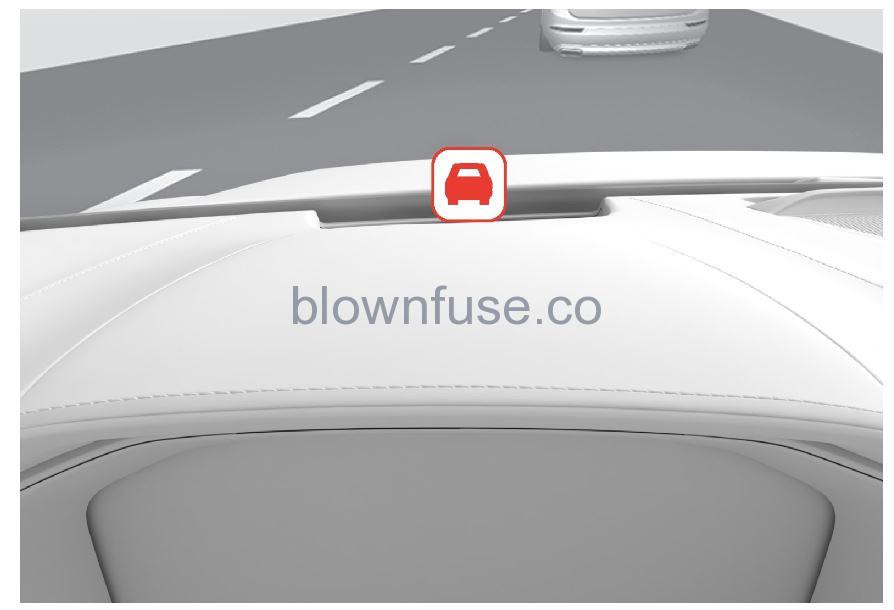
Collision warning symbol on the windshield
NOTE
City Safety can detect pedestrians, cyclists, or vehicles that are stationary, are moving in the same direction as your vehicle, and are ahead of your vehicle. City Safety can also detect pedestrians, cyclists, or large animals that are crossing the road in front of your vehicle.
If there is a risk of a collision with a pedestrian, large animal, cyclist, or another vehicle, the driver will be alerted with light, sound, and pulsations in the brake pedal. At lower speeds, during hard braking or if the accelerator pedal is pressed, the brake pedal pulsation warning will not be given. The intensity of the brake pedal pulsations varies according to the vehicle’s speed.
Brake assistance
If the risk of a collision increases after the collision warning, brake support will be activated.
If the system determines that the pressure the driver is exerting on the brake pedal is insufficient to prevent the collision, brake support will increase pressure.
Auto-brake
The automatic braking function is activated at the last moment.
If the driver has not taken evasive action by this stage and a collision is imminent, the automatic braking function will be triggered. This occurs whether or not the driver is pressing the brake pedal. Full braking force will be applied to reduce the speed at impact or reduced braking effect will be applied if this is sufficient to avoid the collision.
The seat belt tensioner may be activated when the automatic braking function is triggered.
In certain situations, auto-braking may begin with a limited braking force before applying full braking force.
If City Safety has prevented a collision, the vehicle will be kept at a standstill until the driver takes action. If the vehicle has slowed to avoid colliding with a slower-moving vehicle ahead, your speed will be reduced to that vehicle’s speed.
Auto-braking can always be canceled if the driver presses hard on the accelerator pedal.
NOTE
City Safety™
City Safety can alert the driver with light, sound, and pulsations in the brake pedal to help the driver detect pedestrians, cyclists, large animals, and vehicles.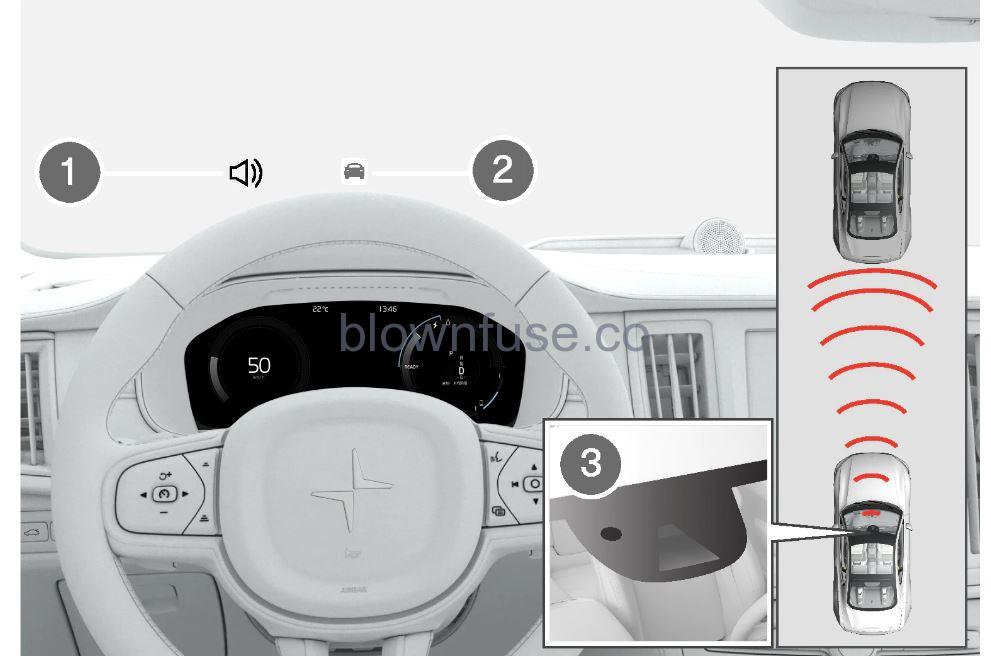
Function overview
- Collision warning audible signal
- Collision warning symbol
- Camera/radar sensor distance monitoring
City Safety can help prevent a collision or lower the vehicle’s speed at the point of impact.
The function can help the driver avoid a collision in e.g. stop-and-go traffic when changes in the traffic ahead and driver distraction could lead to an incident. City Safety activates brief, forceful braking in an attempt to stop your vehicle immediately behind the vehicle or object ahead.
The function assists the driver by automatically applying the brakes if there is an imminent risk of a collision and the driver does not react in time by braking and/or steering away.
City Safety is activated in situations in which the driver should have applied the brakes much earlier, which means that the system will not be able to assist the driver in all situations. The function is designed to be activated as late as possible to help avoid unnecessary intervention. Automatic braking will only be applied after or during a collision warning.
Normally, the occupants of the vehicle will not be aware of City Safety except when the system intervenes when a collision is imminent.
WARNING
- The function is supplementary driver support intended to facilitate driving and help make it safer – it cannot handle all situations in all traffic, weather, and road conditions.
- The driver is advised to read all sections in the Manual about this function to learn of its limitations, which the driver must be aware of before using the function.
- Driver support functions are not a substitute for the driver’s attention and judgment. The driver is always responsible for ensuring the vehicle is driven in a safe manner, at the appropriate speed, at an appropriate distance from other vehicles, and in accordance with current traffic rules and regulations.
Detecting obstacles with City Safety
City Safety can help the driver detect other vehicles, cyclists, large animals, and pedestrians.
VehiclesCity Safety can detect most vehicles that are stationary or are moving in the same direction as your vehicle. In some cases, it can also detect oncoming vehicles and crossing traffic.
For City Safety to be able to detect a vehicle in the dark, its headlights and taillights must be on and clearly visible.
Cyclists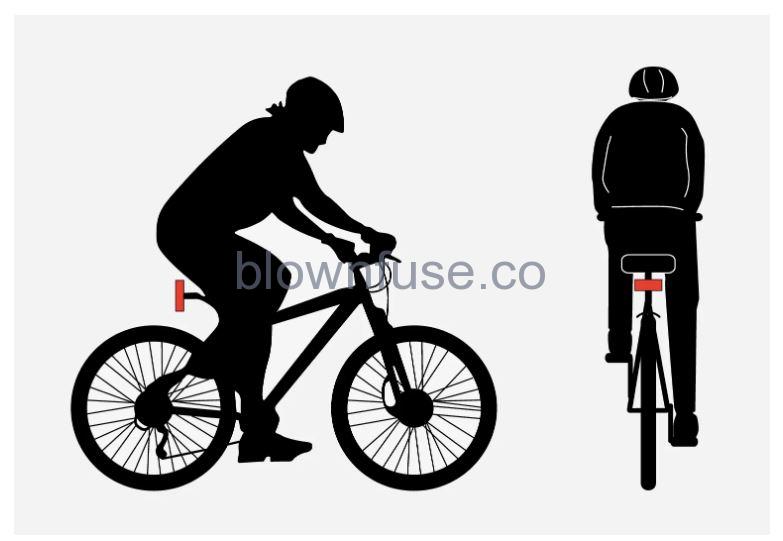
Examples of what City Safety would interpret to be a cyclist: clear body and bicycle shapes.
For good performance, the system’s function for cyclist detection needs the clearest possible information about the contours of the bicycle and of the cyclist’s head, arm, shoulders, legs, torso, and lower body in combination with normal human movements.
If large portions of the cyclist’s body or the bicycle itself are not visible to the function’s camera, it will not be able to detect a cyclist.
The system can only detect adult cyclists riding on bicycles intended for adults.
WARNING
City Safety is supplementary driver support, but it cannot detect all cyclists in all situations and, for example, cannot see:
- partially obscured cyclists.
- cyclists if there is poor contrast to the cyclist’s background.
- cyclists in clothing that hide their body contour.
- bikes loaded with large objects.
In these cases, warnings and braking assistance may come later than usual or not at all. The driver is always responsible for ensuring that the vehicle is driven correctly and with a safety distance suitable for the speed.
Pedestrians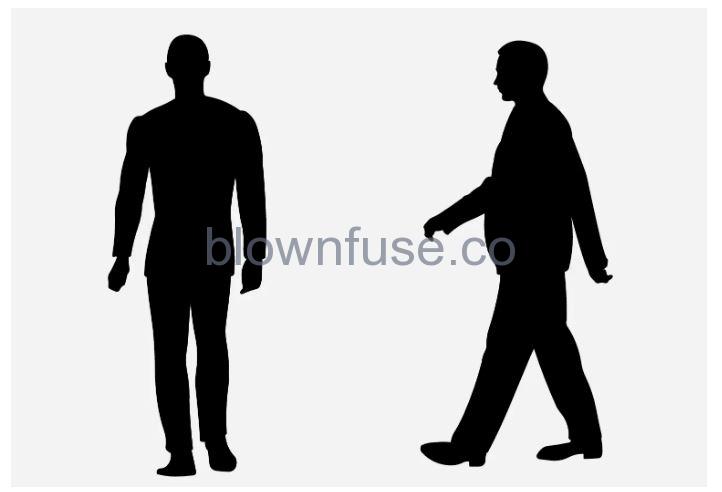
Examples of what the system considers to be a pedestrian: clear body contours.
For good performance, the system’s function for pedestrian detection needs the clearest possible information about the contours of the pedestrian’s head, arm, shoulders, legs, torso, and lower body in combination with normal human movements.
In order to detect a pedestrian, there must be a contrast to the background, which could depend on clothing, weather conditions, etc. If there is little contrast, the person may be detected late or not at all, which may result in a delayed reaction from the system or no reaction at all.
City Safety can detect pedestrians even in dark conditions if they are illuminated by the vehicle’s headlights.
WARNING
City Safety is supplementary driver support, but it cannot detect all pedestrians in all situations and, for example, cannot see:
- partially obscured pedestrians, people in clothing that hides their body contour, or pedestrians shorter than 80 cm (32 in.).
- pedestrians if there is poor contrast to the pedestrian’s background.
- pedestrians who are carrying large objects.
In these cases, warnings and braking assistance may come later than usual or not at all. The driver is always responsible for ensuring that the vehicle is driven correctly and with a safety distance suitable for the speed.
Large animals
Examples of what City Safety would interpret as a large animal: stationary or moving slowly and with clear body contours.
For good performance, the system’s function for detecting large animals (e.g. moose, horses, etc.) needs the clearest possible information about body contours. This entails being able to detect the animal straight from the side in combination with normal movements for that animal.
If parts of the animal’s body are not visible to the function’s camera, the system will not be able to detect the animal.
City Safety can detect large animals even in dark conditions if they are illuminated by the vehicle’s headlights.
WARNING
City Safety is supplementary driver support, but it cannot detect all large animals in all situations and, for example, cannot see:
- partially obscured larger animals.
- larger animals are seen from the front or from behind.
- running or fast-moving larger animals.
- large animals if there is poor contrast to the animal’s background.
- smaller animals such as cats and dogs.
In these cases, warnings and braking assistance may come later than usual or not at all. The driver is always responsible for ensuring that the vehicle is driven correctly and with a safety distance suitable for the speed.
Limitations of City Safety in crossing traffic
In certain situations, it may be difficult for City Safety to help the driver avoid a collision with crossing traffic.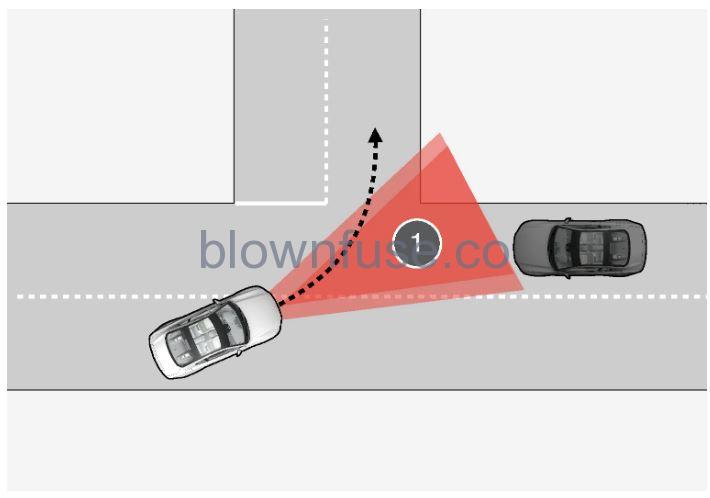
- Sector in which City Safety can detect an oncoming vehicle in crossing traffic.
For example:
- On slippery roads when Electronic Stability Control (ESC) is actively operating.
- If an approaching vehicle is detected at a late stage.
- If the oncoming vehicle is partially obstructed by another vehicle or object.
- If the oncoming vehicle’s headlights are off.
- If the oncoming vehicle is moving erratically and e.g. suddenly changes lanes at a late stage.
NOTE
Setting a warning distance for City Safety
City Safety is always activated but the driver has the option to select the warning distance for the function.
NOTE
The alert distance determines the sensitivity of the system and regulates the distance at which the light, sound, and brake pulsations will be activated.
To select warning distance:
- Select settings in the center display’s Top view.
- Under City Safety Warning, tap Late, Normal, or Early to set the desired warning distance.
If the driver feels that the Earlysetting is giving too many warnings or finds them irritating, the Normal or Late warning distance settings can be selected instead.
When warnings are perceived as being too frequent or disturbing, the warning distance can be reduced, which reduces the total number of warnings and instead leads to City Safety giving a warning at a later stage.
The Late warning distance setting should therefore only be used in exceptional cases, such as when a more dynamic driving style is preferred.
WARNING
- No automatic system can guarantee 100% correct function in all situations. You should therefore never test the use of the function in the direction of people or vehicles – this could lead to severe damage, serious personal injury, or even death.
- The function warns the driver if there is a risk of collision, but the function cannot reduce the driver’s reaction time.
- Even if the Early setting is selected, warnings may be perceived as late in certain situations – e.g. when there are large speed differences or if the vehicle ahead suddenly brakes heavily.
- When Early selected, the warnings will be provided earlier. This may cause the warnings to come more frequently than with the Normal setting, but is recommended since it can make the function more effective.
